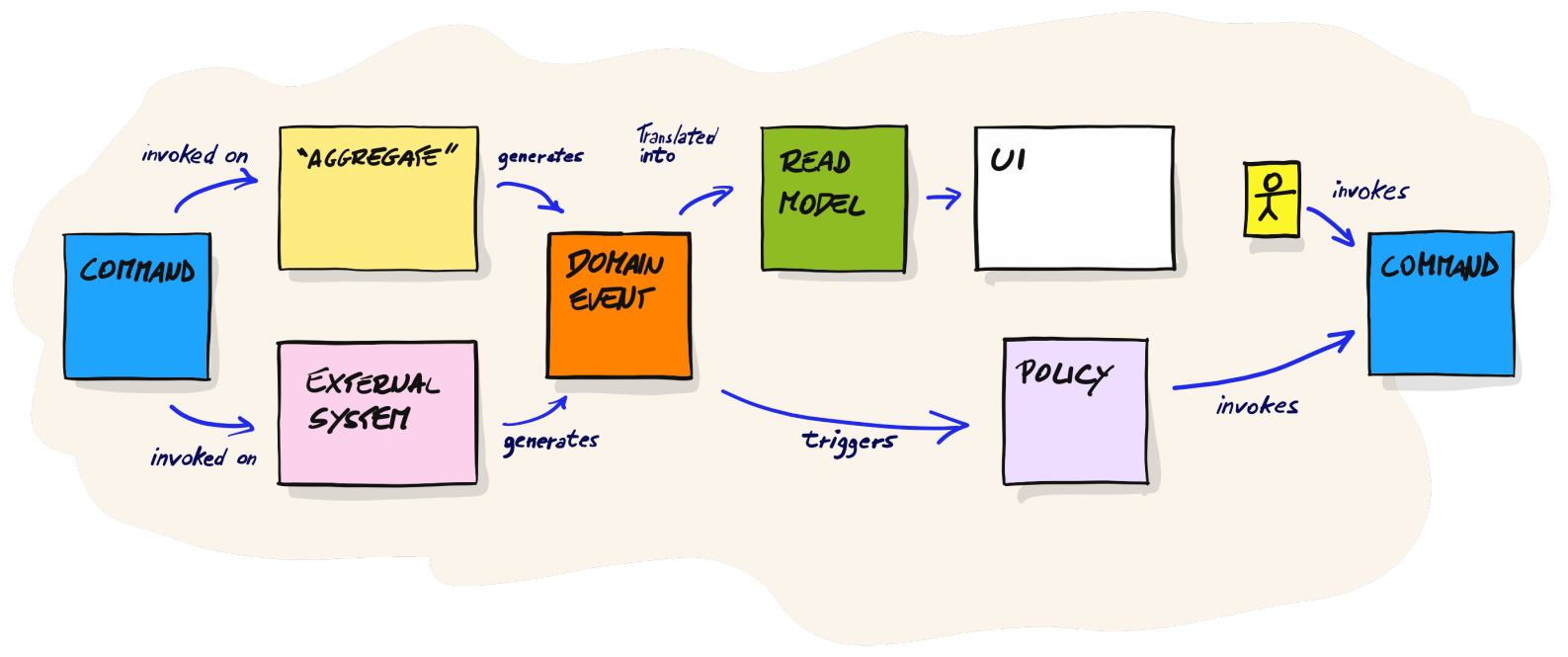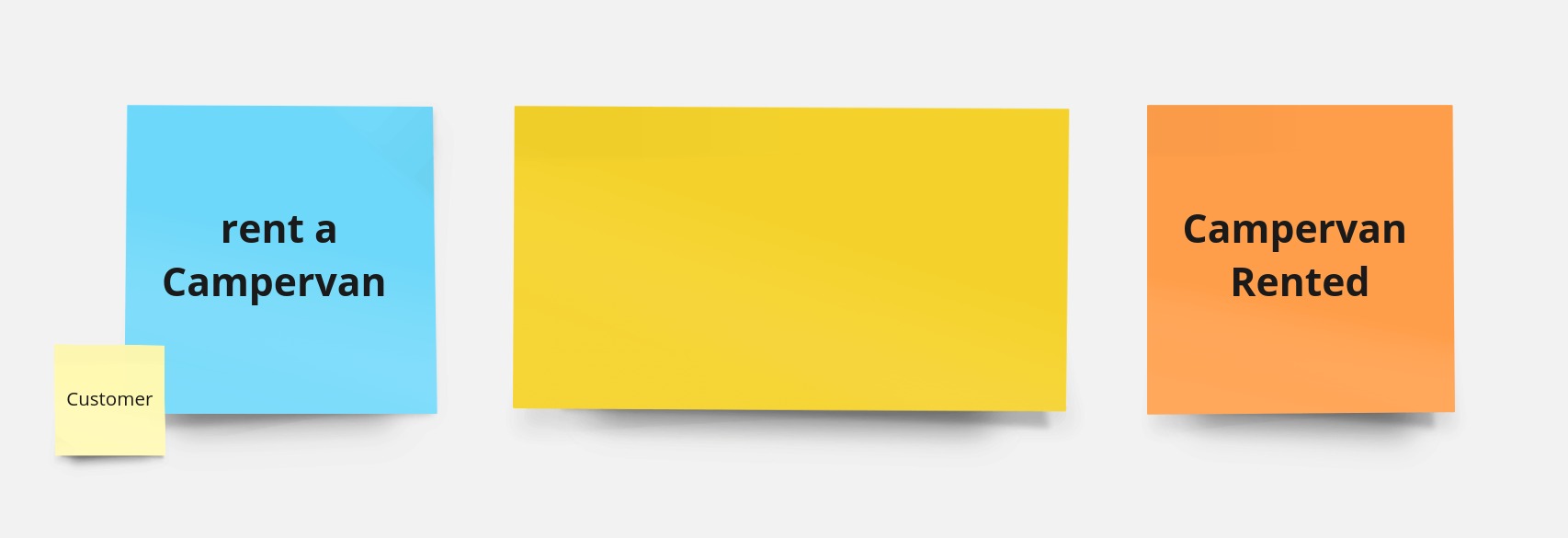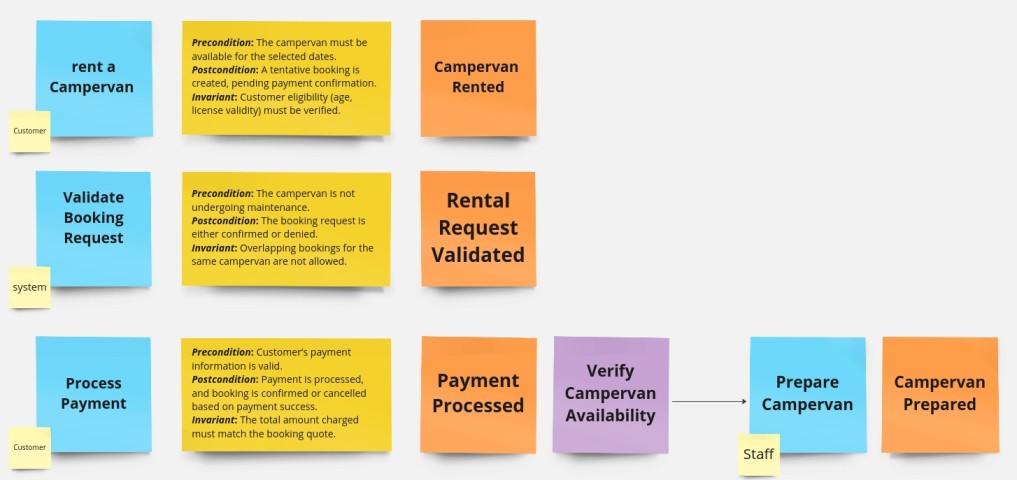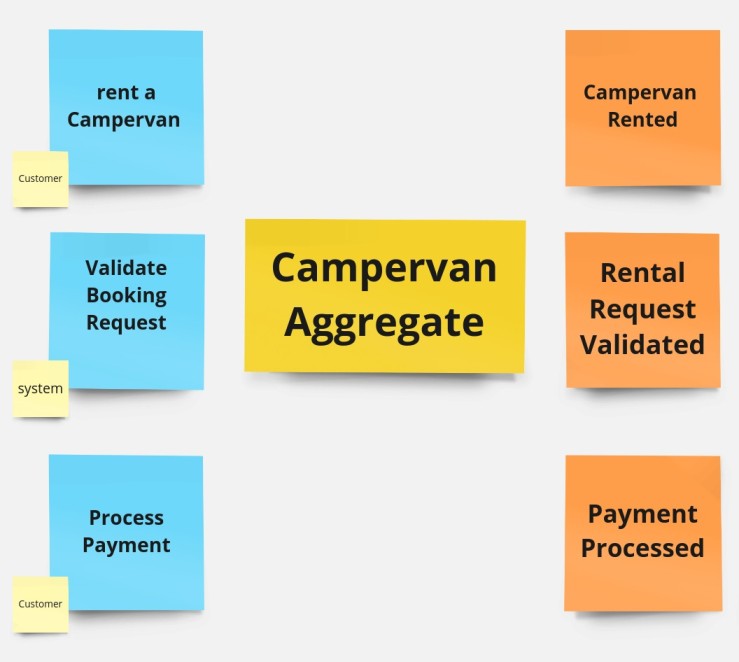Demystifying Event Storming: Design Level, Identifying Aggregates (Part 3)
In Part 3 of a journey through the world of Event Storming, explore the design-level aspect, which emphasizes collaborative exploration, and more!
Join the DZone community and get the full member experience.
Join For FreeIn the first two parts of our series “Demystifying Event Storming,” we embarked on a journey through the world of Event Storming, an innovative approach to understanding complex business domains and software systems. We started by exploring the fundamentals of Event Storming, understanding its collaborative nature and how it differs from traditional approaches. In Part 2, we delved deeper into process modeling, looking at how Event Storming helps in mapping out complex business processes and interactions.
Now, in Part 3, we will focus on the design-level aspect of Event Storming. This stage is crucial for delving into the technical aspects of system architecture and design. Here, we’ll explore how to identify aggregates – a key component in domain-driven design – and how they contribute to creating robust and scalable systems. This part aims to provide practical insights into refining system design and ensuring that it aligns seamlessly with business needs and objectives.
Stay tuned as we continue to unravel the layers of Event Storming, providing you with the tools and knowledge to effectively apply this technique in your projects.
Understanding The Visual Model

The Event Storming Visual Model, as discussed in previous articles, depicts a dynamic and interactive model for system design, highlighting the flow from real-world actions to system outputs and policies.
As previously explained, commands are depicted as decisive actions that trigger system operations, while events are the outcomes or results of those actions within the system. These concepts, which we’ve explored in earlier sections, help guide system design. Policies, which we’ve also covered in previous articles, serve as the guidelines or business rules that dictate how events are handled, ensuring system behavior aligns with business objectives.
The read model, as previously discussed, represents the information structure affected by events, influencing future system interactions. Sketches and user inputs, as mentioned before, provide context and detail, enhancing the understanding of the system’s workings.
Lastly, hotspots, which we’ve touched upon in prior discussions, are identified as critical areas needing scrutiny or improvement, often sparking in-depth discussions and problem-solving during an Event Storming session. This comprehensive model, as previously emphasized, underpins Event Storming’s utility as a collaborative tool, enabling stakeholders to collectively navigate and design complex software architectures.
Abstraction Levels
Event Storming is used to design set of software artifacts that enforce domain logic and bussiness consistency. - Alberto Brandolini
In fact, Event Storming is a powerful technique used to map the intricacies of a system at varying levels of abstraction. This collaborative method enables teams to visualize and understand the flow of events, actions, and policies within a domain.
Big Picture Level
At the Big Picture Level of Event Storming, the primary goal is to establish an overarching view of the system. This stage serves as the foundation for the entire process. Participants collaborate to identify major domains or subdomains within the system, often referred to as “big picture” contexts. These contexts represent high-level functional areas or components that play essential roles in the system’s operation. The purpose of this level is to provide stakeholders with a holistic understanding of the system’s structure and architecture. Sticky notes and a large canvas are used to visually represent these contexts, with each context being named and briefly described. This visualization offers clarity on the overall system landscape and helps align stakeholders on the core domains and areas of focus.
During this stage, participants also focus on identifying and documenting potential conflicts within the system. Conflicts may arise due to overlapping responsibilities, resource allocation, or conflicting objectives among different domains. Recognizing these conflicts early allows teams to address them proactively, minimizing challenges during the later stages of design and development.
In addition to conflicts, participants at the Big Picture Level work to define the system’s goals. These goals serve as the guiding principles that drive the system’s design and functionality. Clear and well-defined goals help ensure that the subsequent design decisions align with the system’s intended purpose and objectives.
Blockers, which are obstacles or constraints that can impede the system’s progress, are another key consideration at this level. Identifying blockers early in the process enables teams to devise strategies to overcome them effectively, ensuring smoother system implementation. Conceptual boundaries define the scope and context of each domain or subdomain. Understanding these boundaries is essential for ensuring that the system operates seamlessly within its defined constraints.
The Big Picture serves as a starting point for addressing these elements, allowing stakeholders to gain insights into the broader challenges and opportunities within the system. This comprehensive view not only aids in understanding the system’s structure but also lays the groundwork for addressing these elements in subsequent levels of abstraction during Event Storming.
Process Level
The Process Level of Event Storming delves deeper into the specific business processes or workflows within each identified context or domain. Participants collaborate to define the sequence of events and actions that occur during these processes. The primary goal is to visualize and understand the flow of actions and events that drive the system’s behavior. This level helps uncover dependencies, triggers, and outcomes within processes, providing a comprehensive view of how the system operates in response to various inputs and events. Sticky notes are extensively used to represent events and commands within processes, and the flow is mapped on the canvas. This visual representation clearly shows how events and actions connect to achieve specific objectives, offering insights into process workflows.
At the Process Level, it’s essential to identify the value proposition, which outlines the core benefits that the system or process delivers to its users or stakeholders. Understanding the value proposition helps participants align their efforts with the overall objectives and ensures that the designed processes contribute to delivering value. Policies represent the rules, guidelines, and business logic that govern how events are handled within the system. They define the behavior and decision-making criteria for various scenarios. Recognizing policies during Event Storming ensures that participants consider the regulatory and compliance aspects that impact the processes.
Personas are fictional characters or user profiles that represent different types of system users. These personas help in empathizing with the end-users and understanding their needs, goals, and interactions with the system. Incorporating personas into the process level enables participants to design processes that cater to specific user requirements. Individual Goals refer to the objectives and intentions of various actors or participants within the system. Identifying individual goals helps in mapping out the motivations and expected outcomes of different stakeholders. It ensures that the processes align with the diverse goals of the involved parties.
Design Level
At the Design Level of Event Storming, the focus shifts to the internal behavior of individual components or aggregates within the system. Participants work together to model the commands, events, and policies that govern the behavior of these components. This level allows for a more granular exploration of system behavior, enabling participants to define the contracts and interactions between different parts of the system. Sticky notes continue to be utilized to represent commands, events, and policies at this level. These notes provide a detailed view of the internal workings of components, illustrating how they respond to commands, emit events, and enforce policies. The Design Level is crucial for defining the behavior and logic within each component, ensuring that the system functions as intended and aligns with business objectives.
Identifying Aggregates
Event Storming intricately intertwines with the principles and vocabulary of Domain-Driven Design (DDD) to model and elucidate technical concepts. We reach a crucial and often challenging aspect of Domain-Driven Design (DDD) – understanding and identifying aggregates. Aggregates, despite being a fundamental part of DDD, are commonly one of the least understood concepts by engineers. This lack of clarity can lead to significant pitfalls in both system design and implementation. Aggregates are more than just collections of objects; they represent carefully crafted boundaries around a set of entities and value objects. These boundaries are crucial for maintaining data integrity and encapsulating business rules. However, engineers often struggle with understanding the optimal size and scope of an aggregate, leading to either overly large aggregates that become bottlenecks or too many small aggregates that make the system unnecessarily complex. I recommend reading my separate article dedicated to understanding aggregates in DDD, which lays the foundation for the concepts we’ll explore here.

In the intricate process of Design Level Event Storming, especially when identifying and defining aggregates for a complex system like a campervan rental service, the foremost step is to ensure the involvement of the right mix of people, and change people. This team should ideally be a blend of domain experts, who bring in-depth knowledge of the campervan rental business, and technical specialists, such as software developers and architects. Their combined insights are crucial in ensuring that the identified aggregates align with both business realities and technical feasibility. Additionally, including individuals with a focus on user experience is invaluable, particularly for aspects of the system that directly interact with customers.
Once this diverse and knowledgeable team is assembled, a pivotal initial step is to revisit and reflect upon the insights gained from the Process Level. This stage is crucial as it provides a rich tapestry of information about the business workflows, key events, commands, and the intricate policies that were identified and explored previously. It’s at this juncture that a deep understanding of how the business operates comes to the forefront, offering a nuanced perspective that is essential for the next phase of aggregate identification and design.
In Event Storming, the flow often goes from a command (an action initiated) to a domain event (a significant change or result in the system). However, there’s usually an underlying business rule that dictates how and why this transition from command to event happens. This is where blank yellow sticky notes come in. The blank yellow sticky note serves as a placeholder for the business rule that connects the command to the domain event. It represents the decision-making logic or criteria that must be satisfied for the event to occur as a result of the command.
 When a command and its corresponding domain event are identified, a blank yellow sticky note is placed between them. This signifies that there is a business rule at play, influencing the transition from the command to the event. The blank state of the sticky note invites team members, especially domain experts, to discuss and identify the specific rule or logic. This is a collaborative process where different perspectives help in accurately defining the rule. Through discussion, the team arrives at a clear understanding of the business rules. Participants are asked to fill in these business rules on the yellow sticky notes with comprehensive details about their execution. This involves several key aspects:
When a command and its corresponding domain event are identified, a blank yellow sticky note is placed between them. This signifies that there is a business rule at play, influencing the transition from the command to the event. The blank state of the sticky note invites team members, especially domain experts, to discuss and identify the specific rule or logic. This is a collaborative process where different perspectives help in accurately defining the rule. Through discussion, the team arrives at a clear understanding of the business rules. Participants are asked to fill in these business rules on the yellow sticky notes with comprehensive details about their execution. This involves several key aspects:
- Preconditions: What must be true before the rule is executed? For instance, before the Rent Campervan command can succeed, a precondition might be that the selected campervan must be available for the chosen dates.
- Postconditions: What becomes true after the rule is executed? Following the campervan rental, a postcondition would be that the campervan’s status changes to "rented" for the specified period.
- Invariants: What remains true throughout the execution of the rule? An invariant could be that a customer’s account must be in good standing throughout the rental process.
- Additional information: Any other clarifications or details that help in understanding what the business rule does
Some business rules might be straightforward, but others could lead to extensive discussions. This interaction is a crucial part of the knowledge-sharing process. It allows domain experts to clarify complex business logic and developers to understand how these rules translate into system functionality. These discussions are invaluable for ensuring that everyone has a clear and shared understanding of how the business operates and how the system should support these operations.

This process goes with an in-depth analysis of the various events and commands that had emerged in earlier stages. We noticed a distinct pattern: a cluster of activities and decisions consistently revolved around the management of campervans. The technique involves physically moving these similar business rules on top of one another on the board where the Event Storming session is visualized. This action is more than just an organizational step; it’s a method to highlight and analyze the interrelations and potential redundancies among the rules.

This consolidation helps in clearly seeing how different rules interact with the same set of data or conditions. It can reveal dependencies or conflicts between rules that might not have been evident when they were considered in isolation. By grouping similar rules, you simplify the overall complexity of the system. It becomes easier to understand and manage the business logic when it’s seen through grouped, related rules rather than as a multitude of individual ones. This process can also uncover opportunities to refine or merge rules, leading to more streamlined and efficient business processes.
Moreover, a closer look at the operational challenges and data cohesion associated with campervans solidified our thinking. We realized that managing various aspects related to campervans under a unified system would streamline operations, reducing complexities and enhancing service efficiency. The disparate pieces of information - maintenance schedules, booking calendars, location tracking - all pointed towards a need for an integrated approach.
The decision to establish an aggregate was a culmination of these observations and discussions. It was a decision driven not just by operational logic but by the natural convergence of business activities related to campervans. By forming this aggregate, we envisioned a system where all aspects of a campervan’s lifecycle were managed cohesively, ensuring seamless operations and an enhanced customer experience.
This approach also brought into focus the need for enforcing consistency across the campervan fleet. By designing an aggregate to encapsulate all aspects related to each vehicle, we ensured that any changes - be it a rental status update or a maintenance check - were consistently reflected across the entire system. This consistency is crucial for maintaining the integrity and reliability of our service. A campervan, for instance, should not be available for booking if it’s scheduled for maintenance. Similarly, the location information of each campervan needs to be accurate and up-to-date to ensure efficient fleet management.
Imagine a scenario where a customer books a campervan for a journey from Munich to Paris. Within the aggregate, several pieces of information about each campervan are tracked and managed, including its current location, availability status, and maintenance schedule. When the customer selects a specific campervan for their dates, the aggregate immediately updates the vehicle’s status to "rented" for that period. This update is critical to ensure that the same campervan isn’t available for other customers for the same dates, preventing double rentings.
Simultaneously, let’s say this chosen campervan is due for maintenance soon after the customer’s proposed return date. The system, adhering to the rules within the aggregate, flags this campervan for maintenance, ensuring that it does not get rented again before the maintenance is completed.
Invariants, or rules that must always hold true, became a cornerstone in the design of the aggregate. These invariants enforce critical business rules and ensure the validity of the system at all times. For example, an invariant in our system ensures that a campervan cannot be simultaneously booked and marked as under maintenance. Such invariants are essential for maintaining data integrity and providing a consistent, reliable service to our customers.
Let’s consider a real-life scenario to illustrate this: A family eagerly plans a summer road trip from Munich to the picturesque landscapes of Paris. They find the perfect campervan on our website and proceed to rent it for their adventure. Unseen to them, but crucial for their journey, is the role of our invariant at play.
As soon as they select their dates and campervan, the system springs into action. It checks the aggregate, specifically probing for two critical conditions – is the chosen campervan already rented for these dates, and is it due for maintenance? This is where the invariant exerts its influence. It steadfastly ensures that this campervan is neither engaged in another journey nor scheduled for a maintenance check during the requested time. This rule is inflexible, a cornerstone of our commitment to reliability.
These invariants, embedded within our aggregate, are more than just lines of code or business policies. They are a promise – a promise of adventure without the unexpected, of journeys that create memories, not mishaps. By ensuring that each campervan is adequately prepped and available for every booking, these rules not only keep our operations smooth but also cement our reputation as a reliable and customer-centric business.
In our exploration of the campervan rental business through Event Storming, we’ve identified a multitude of individual events, commands, and policies. However, these elements gain true significance only when they are clustered together as a cohesive unit. This clustering is what forms the essence of the aggregate. It’s a conceptual realization that the isolated pieces - rentals, maintenance schedules, customer interactions - are interdependent and collectively form the core of our service. Without this unification, each element would merely exist in a vacuum, lacking context and impact.
The heart of this aggregate, its root, is the campervan itself. The campervan is not just a physical entity but a nexus of various business processes and customer experiences. We selected the campervan as the aggregate root because it is the central element around which all other activities revolve. Whether it’s booking a campervan, preparing it for a customer, or scheduling its maintenance, every action directly relates to the individual campervan. This choice reflects our understanding that the campervan is the linchpin of our business model, directly influencing customer satisfaction and operational efficiency.
Alberto Brandolini emphasized the "blank naming" strategy. At the initial phase, rather than rushing to assign specific names or predefined functions to aggregates, the team is encouraged to recognize them in a more open-ended manner.
The Naming of Aggregates
This step, strategically placed at the end of the session, is more than just a labeling exercise; it is the final act of distilling and synthesizing the insights gained throughout the event. Early in the session, it might be tempting to assign names to these Aggregates. However, this urge is resisted, as premature naming can lead to misconceptions. Names given too early might not fully capture the essence of what an Aggregate represents, as they are based on an initial, incomplete understanding of the system. Therefore, the practice of waiting until the end to name these Aggregates is not just a procedural step; it is a deliberate choice to ensure accuracy and relevance in naming.

Thus, the Campervan Aggregate, with the campervan as its root, becomes a powerful tool in our system architecture, encapsulating the complexity of our operations into a manageable and coherent structure.
Conclusion
As we conclude Part 3 of “Demystifying Event Storming: Design Level, Identifying Aggregates,” we have navigated the intricate process of identifying aggregates, a pivotal aspect in Domain-Driven Design. This journey through the Design Level has illuminated the profound utility of Event Storming in mapping complex systems, highlighting the importance of a collaborative approach and the strategic use of the blank naming strategy.
The emergence of the Campervan Aggregate in our rental business model is a testament to the effectiveness of this methodology. It underscores how well-defined aggregates can streamline system design, ensuring alignment with business objectives. The decision to name these aggregates at the end of the session, based on deep insights and understanding, has been crucial in accurately reflecting their roles within the system.
Looking ahead, our series will continue to explore the depths of Event Storming. In the next installment, we will delve into identifying bounded contexts, a key concept in Domain-Driven Design that further refines our understanding of complex systems. This next phase will focus on how bounded contexts help in delineating clear boundaries within the system, facilitating better organization and more efficient communication across different parts of the system.
Opinions expressed by DZone contributors are their own.

Comments